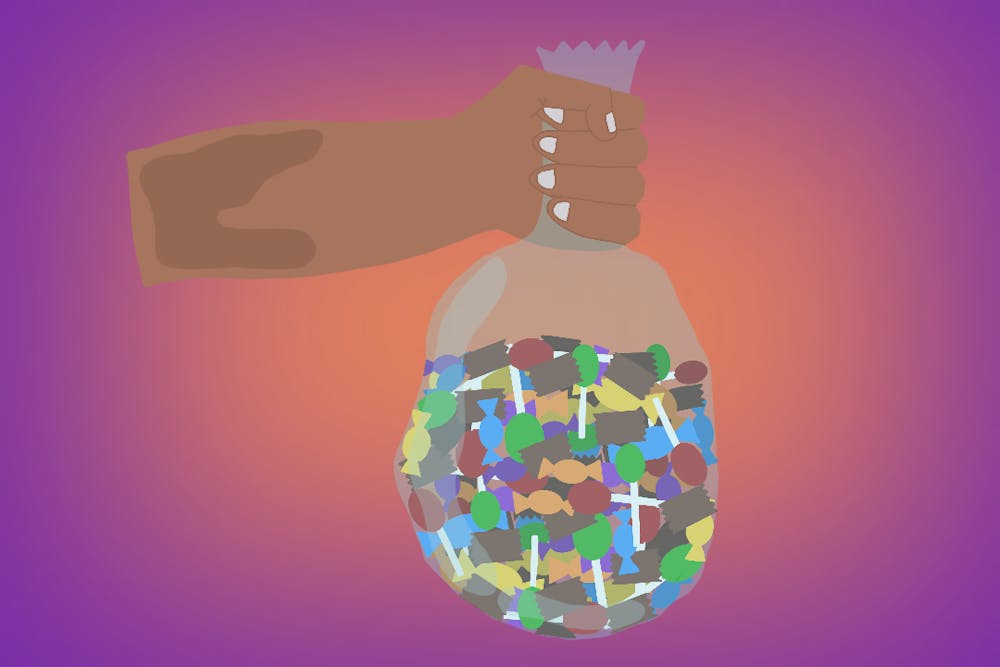We all love a sweet treat, don't we? It almost feels like a reward: a sweetened morning coffee to prepare for the long day ahead or a late-night ice cream as a prize for a day's work.
There is nothing wrong with an occasional sweet treat but consistently eating sugar can add up in ways people do not realize, potentially leading to serious health consequences.
Sugar hides in everyday food and drinks, it is not confined to candy, soda or desserts. It's in sauces, sports drinks, protein bars and other foods that are deemed "healthy."
The Food and Drug Administration said it suggests the daily sugar intake be less than 10% of the total daily calories. Following the typical 2,000 calorie diet, means 200 calories or 50 grams would be the recommended sugar intake, said Maggie Symes, a current dietetic intern and a graduate student studying nutritional science.
But how much is 50 grams of sugar? Imagine an 8.4 fluid ounce can of Red Bull that contains 27 grams of sugar. That single Red Bull already contains half of the daily limit. Even a Cool Blue Gatorade, people often drink after a workout, contains 34 grams of sugar, according to Dorcas Jing Teng Chong, a current dietetic intern and a graduate student studying nutritional science.
Consuming a Red Bull and Cool Blue Gatorade means the daily limit has been passed without counting anything else. Reading food labels and understanding the amount of sugar consumed is important to avoid diseases such as diabetes, heart disease and cancer.
"The food industry uses a wide variety of terms for sugar, which can make it harder to spot," Chong said.
Different names for sugar include maltose, honey, corn syrup, molasses, agave, dextrose and more. Another tactic food producers use is labelling certain claims on packages such as sugar free, reduced sugar or low in added sugar. However, these names are not necessarily honest.
According to the American Heart Association, sugar free means the item contains less than 0.5 grams of sugar per serving. Reduced sugar means it contains at least 25% less sugar than the traditional version. No sugar added means that in the process of manufacturing the product, no ingredients containing sugar were added — that is not to say the food has no natural sugar. Low in added sugar means it makes up less than 5% of the daily recommended value.
"By paying attention to these labels on our food products, we can better understand the sugar content of the food we eat and make more informed choices that align with our personal health goals and dietary needs," Chong said.
Along with reading labels, understanding the scientific workings of how our body digests sugar is important to make healthy choices. Sugar is a simple carbohydrate that provides a quick source of energy and that sweet taste, Chong said.
When eating foods that contain sugar, the digestive system breaks it down into simple sugar molecules, Chong said. Once broken down, the molecules are absorbed and metabolized into the bloodstream and sent to cells. However, the cells are not able to distinguish where the sugars come from.
"Whether it's from a potato, an apple or candy, they treat all simple sugars the same way, absorbing and metabolizing them for energy regardless of their sources," Chong said.
Carbohydrates within foods affect blood sugars. Not all carbohydrates have the same effect on the body but all will eventually break down into glucose.
The process to break down carbohydrates and sugar works when the body is in balance, but if sugar is consistently over-consumed, there is risk for permanent damage on the body.
Some prevention methods include focusing on whole natural foods, exercising regularly, limiting sugar intake to less than 10% of total calories and finding substitutes for sweetened foods and beverages, Symes said.
"It appears that sugars are more prevalent in our diets than we might have initially realized," Chong said. "This makes it important for us to understand their sources and effects on our health."
Edited by Senna James, Sophia Ramirez and Madeline Schmitke.
Reach the reporter at nrodri74@asu.edu.
Like The State Press on Facebook and follow @statepress on X.




